|
19th-22nd July:
Highlights of Orkney part 2
Thursday 19th
July: Broch
of Gurness
Generically speaking, a
“broch” is a dry-stone roundhouse, built around
2000
years ago, that was used as a fortress, often incorporating community
dwellings. They are unique to the Atlantic coastline of Scotland. The
broch at
Gurness is situated on the north of Mainland, the biggest island of the
Orkney
archipelago. On the morning we visited, the weather was perfect for
viewing the
Broch and also for watching the surrounding flora and fauna. Some
Arctic Terns
were patrolling the Eynhallow Sound, the channel separating Mainland
from the Isle
of Rousay. A pair of Gannets did likewise a short time later. As I
explored the
Broch remains, I heard some tourists getting excited about the
appearance of a
Common Seal that had briefly surfaced in the Sound.
|
Arctic Tern |
Gannet |
Common Seal |
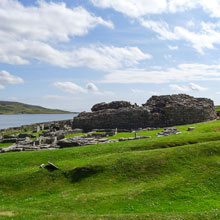 |
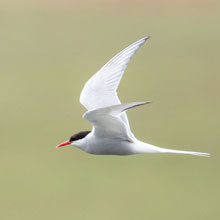 |
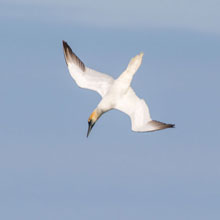 |
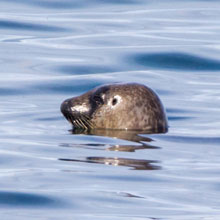 |
A female Eider
flew past the Broch and later another passed rather more
sedately as she guided her ducklings along the shoreline. As I snapped
some
pictures of some pretty Common Ragwort I noticed an Antler Moth feeding
on Hogweed.
The antler-shaped marks on its upper wing give it its common name. It
flies
during daylight hours.
| Female Eider |
Juvenile Eider |
Common Ragwort |
Antler Moth |
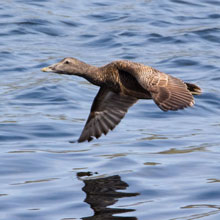 |
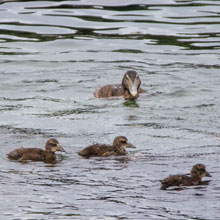 |
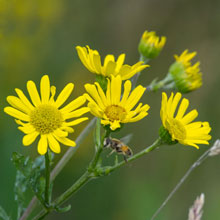 |
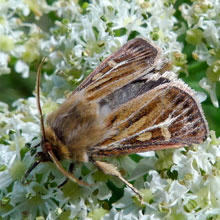 |
Thursday 19th
July 2018:
Brough of Birsay
Birsay is a
small island just off the northwest corner of Mainland. It can
be accessed easily by foot, but only at low tide, via a 240m long
causeway.
It’s name derives from old Norse for “fort
island”. You may have assumed that
the term “Brough” derives from
“broch”, as above, and you would be right. So
the Brough of Birsay is simply the “fort of fort
island”! During the first
millennium it has been occupied by Picts and then Vikings. Unfortunately I timed
our visit badly since it was high tide at our arrival,
which meant we could only look across at the island. I contented myself
with an
exploration of the mile of coast immediately to the east of the car
park.
Luckily there were lots of things to see. First up were the ubiquitous
Fulmars,
which I managed to photograph on their cliffside perches. I also came
across
lots of Green-veined White butterflies in the bracken. Females were
positioning
themselves on leaves as the eager males sought them out. Some Black
Guillemots
sat lazily on an exposed cliff top. They seemed unconcerned with our
presence.
Conversely, a pair of quite aggressive Arctic Terns appeared on the
scene,
swooping threateningly close to our heads. I got the message that we
were too
close to their nesting area, so we passed quickly by.
| Fulmar |
Green - veined White Butterfly |
Black Guillemot |
Arctic Tern |
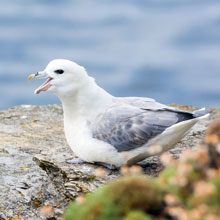 |
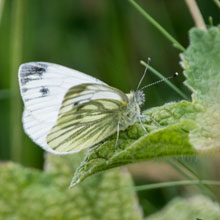 |
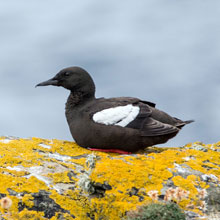 |
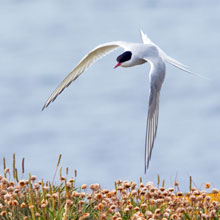 |
From a safer
distance I managed to catch the Terns sitting on the same rock
cliff as the Guillimots. A Rock Pipit hopped into view and probably
wondered
what the fuss was about. About a kilometre from the car park we came
upon an
interesting hut that was built into the grassy banks at the top of a
small
cove. Surrounding the hut there were several large, puzzling
indentations in
the banks. It turns out that this was a 19th century
fishermens’ rest and the
indentations, called “nousts”, were used to hold
their boats after they had
been hauled up from the cove. At the Point of Nether Queena 100m
further on,
there is a whalebone
sculpture. The picture below shows it with the Brough of
Birsay in the background. The sculpture is all that remains of a Baleen
whale
that was washed up offshore in the 1870s.
It was very
grey, damp weather when I set out around the Mull Head Local
Nature Reserve, which is at the east of Mainland, at the north of a
peninsula
called Deerness. Not far from the car park is a feature called The
Gloup, which
is a collapsed sea cave separated from the sea by an 80m land bridge.
From a
specially-build viewing platform I photographed a Black Guillemot
sitting on
high ledge overlooking the chasm. I moved onto the land bridge and,
from my
trusty 3-legged stool, I observed the movements of Cormorants, Black
Guillemots
and Shags, all of which were very active. I saw a Black Guillemot
carrying what
looked like an eel.
| The Gloup |
Cormorant |
Black Guillemot |
Shag |
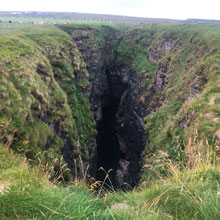 |
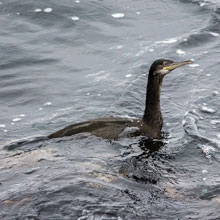 |
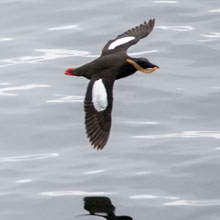 |
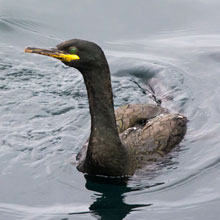 |
From there I
trekked the few miles past some dramatic rocky shoreline
towards the Head. Unfortunately I didn’t reach my destination
as in order to
access the last few hundred yards I needed to climb a stairway cut into
the
side of a cliff. It was like something out of an Indiana Jones movie,
and wet
into the bargain, so I gave it a miss. However I did manage some nice
shots of
Fulmar. On my return trip I came across lovely flowers of the Grass of
Parnassus. This very pretty flower, which smells like honey, is
so-named after
the story that cattle grazing on Mount Parnassus, in Greece, developed
a taste
for the plant, rather than grass. There were also lots of patches of
Eyebright
with its very tiny, but beautiful flowers. It is semi-parasitic as it
often
robs other plants of nutrients by surrounding and seeking them out with
its roots.
| Cliff Path |
Fulmar |
Grass Of Parnassus |
Eyebright |
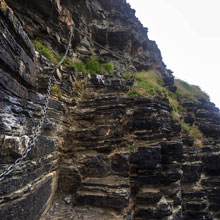 |
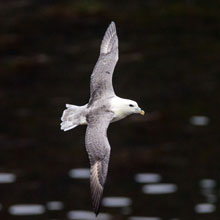 |
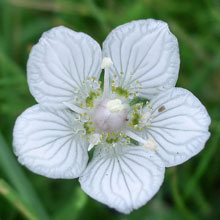 |
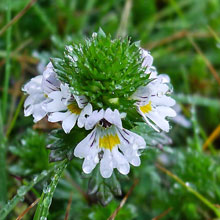 |
Saturday 21st
July 2018: Yesnaby
10 minutes
drive from Stromness, Yesnaby is on the west coast of
Mainland.
It is renowned for its dramatic old Red Sandstone cliffs and sea
stacks. The
car park looked like a former military station. As we began our trek,
Rock Pipits posed conveniently and the air was filled with Fulmars.
Great Skuas
glided past every so often. We reached the very impressive Castle Stack
set in
very rugged coastline. It stands on 2 legs and is 35m tall and has been
described as a smaller version of the more famous Old Man of Hoy.
| Rock Pipit |
Fulmar |
Great Skua |
Castle Stack |
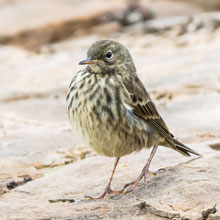 |
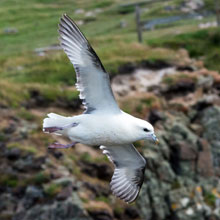 |
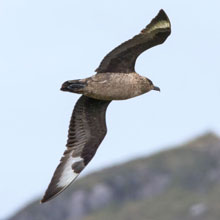 |
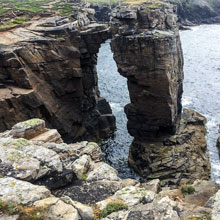 |
Yesnaby is a
location where the fairly rare Scottish
Primrose
can be found. I had a good look for it but I think our visit was the
wrong
part of the season to catch the flower in bloom. There were lots of
Devil’s Bit
Scabious and Spear Thistle. Like Mull Head, there were a fair number of
Grass
of Parnassus and Eyebright.
| Devil's Bit Scabious |
Spear Thistle |
Grass Of Parnassus |
Eyebright |
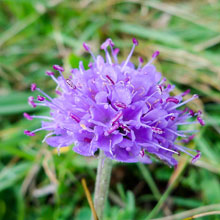 |
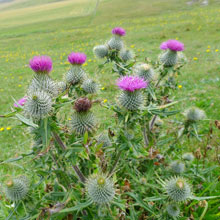 |
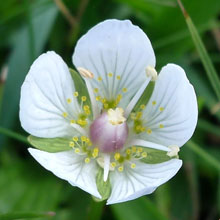 |
 |
Sunday 22nd
July 2018: Stromness to Scrabster ferry crossing
I was
disappointed that the weather when we set off was even more miserable
than on our ferry trip onto Orkney. However as the crossing progressed,
the
light improved and I managed a few very satisfying shots of Gannets and
Fulmars. I also captured an image of a Kittiwake sweeping over the
waves.
We were sad to
leave the Orkney Isles as we had had many stimulating,
exciting and entertaining experiences. We concentrated most of our
birdwatching
efforts on the coastal areas, so there’s a strong possibility
that I’ll return
there in the future as I’d like to explore the inland areas
of Mainland. Also
the other islands in the archipelago offer some very tempting sites.
Pictures of the
Week:
| Antler Moth |
Fulmar |
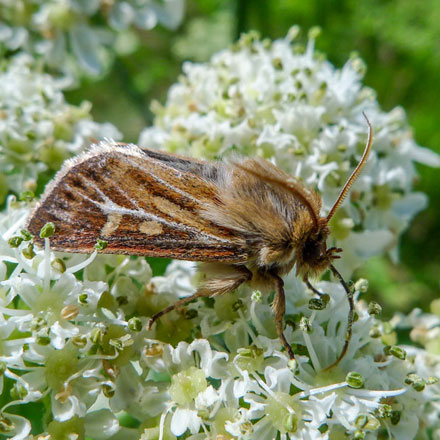 |
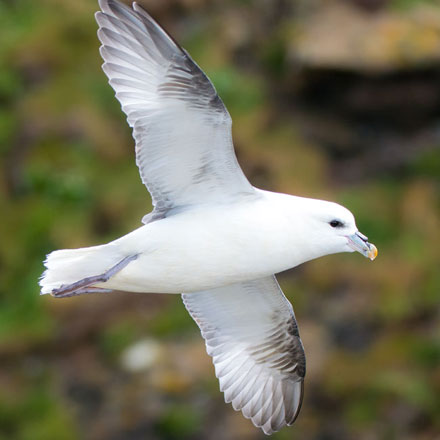 |
| Spear Thistle |
Gannet |
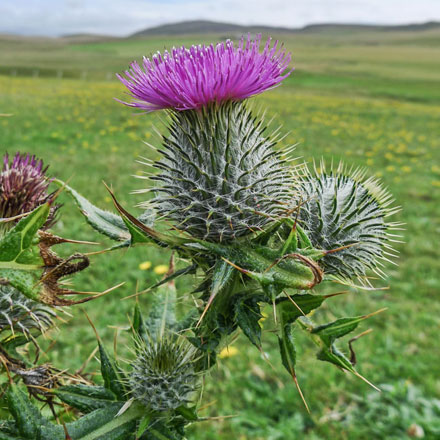 |
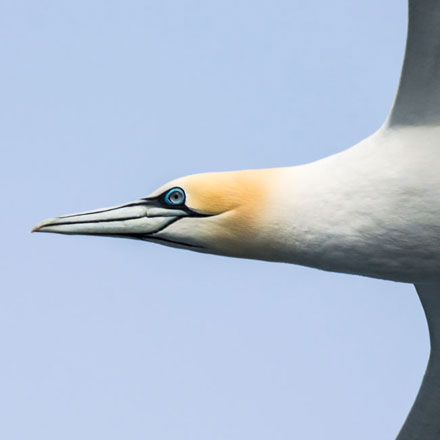 |
15-18th
July 2018:
Highlights of Orkney Vacation Part 1
Sunday 15th
July: Dornoch
and Dunrobin
Castle:
On Saturday
14th July my wife and
I battered up the infamous A9, on a 10-day holiday in the North of
Scotland. We were heading for Orkney but our plan was to break the
journey with a 2-night stay in lovely Dornoch. We spent Sunday visiting
the nature reserve near there, at Loch Fleet where, despite some dull,
drizzly weather, we were treated to magnificent views of Common and
Grey Seals languishing on golden sands. We were also lucky enough to
glimpse views of an Osprey hunting for fish, but we were unlucky in
that it didn’t treat us to a view of its fishing skills. In
the
afternoon we further sheltered from the rain by taking a tour of
Dunrobin Castle, the home of the Duke of Sutherland, notorious for his
role in the Highland
Clearances.
His huge hillside monument looms threateningly over the area.
We
attended a very enjoyable and informative falconry display in the
Castle Gardens. I usually dislike such things involving captured
animals, but the skill of the falconer and the various raptors on show,
such as Peregrine and Golden Eagle, certainly won me over.
Common Seal
|
Osprey
|
Peregrine Falcon
|
Golden Eagle
|
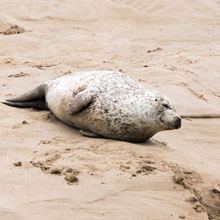 |
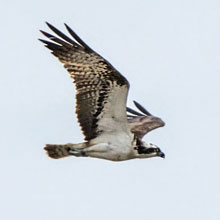
|
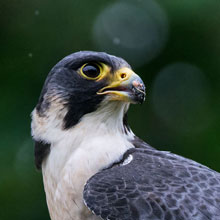
|
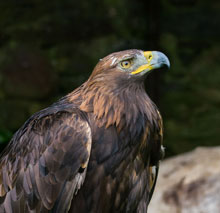
|
Monday 16th
July: Old Man of Hoy:
The next day we
made the one and a
half hour drive to Scrabster, near Thurso, and boarded the Orkney
ferry, MV Hamnavoe, (“haven bay”), the ancient
Norse name for
Stromness, our destination port. The weather remained disappointingly
drizzly, but as we passed the world famous rock stack, the Old Man of
Hoy, we were greeted by a host of sea birds including Fulmars, Great
Skuas (also known as Bonxies) and Gannets, as well as more distant
views of Guillemots, Razorbills and Penguins (more of which later).
Tuesday 17th
July 2018: RSPB
Hobbister:
After we had
settled into our digs
and explored Kirkwall we checked out RSPB Hobbister which is on the
north-east edge of Scapa
Flow
, the natural harbour famous for its sheltered waters used by ships
since ancient times and for the part it has played in travel, trade and
conflict, especially during the World Wars. Unfortunately the rain did
not show the reserve in its best light. Also, young canoeists were
active around the bay effectively clearing birds and other wildlife
from the immediate area. I did however manage some nice shots of a pair
of not-so-shy Stonechats in bracken beside the the road. And a Magpie
Moth caught my attention before darting into the bracken. Looking quite
butterfly-like, these Orkney moths apparently feeds on heather rather
than the gooseberries favoured by Magpie Moths in the South. As I
returned to the car I snapped a Devil’s Bit Scabious. This
plant is
so-named after the fact that it was used in the treatment of scabies
and other skin conditions. It's roots look as if they have been cut
short - which, to the ancients, seemed to be the work of the Devil.
Male
Stonechat
|
Female Stonechat
|
Magpie Moth
|
Devil's Bit Scabious
|
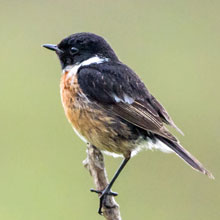
|
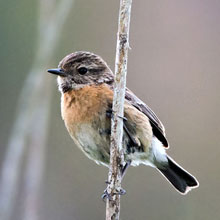
|
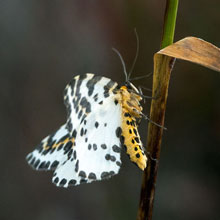
|
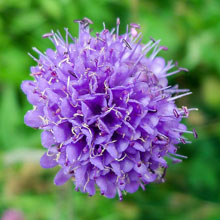
|
Tuesday 17th
July 2018: Ring of Brodgar
The weather was much better
in the
afternoon, very bright, warm and dry.
Most of our time was taken up by a visit to Ness of Brodgar,
where a
live
archeological dig was in process. .
Later we walked around a pair of ancient stone circles, the Stones of
Stenness
and the Ring of Brodgar. It all seemed a bit “Harry
Potter”. In the car
park I
came across the scary-looking wasp, Buathra Laborator, and a large,
attractive
caterpillar of the Emperor Moth which feeds on heather, bramble and
blackthorn.
Wednesday 18th
July 2018:
RSPB Marwick Head
On the
following afternoon I spent
a few hours taking pictures around RSPB Marwick Head (my wife preferred
to stay in the car with her knitting!). As I set off, I noticed the
edges of the shore were lined with wildflowers, Oxeye Daisies, Sea
Campion, Sea Sandwort and Marsh Woundwort. I paused to get some
pictures of these before approaching the many collections of birds on
and around the steep, high and dangerous sea cliffs.
Oxeye Daisy
|
Sea Campion
|
Sea Sandwort
|
Marsh
Woundwort
|
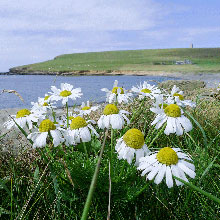
|
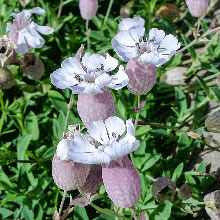
|
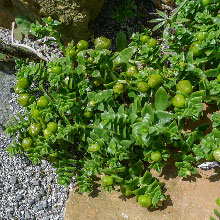
|
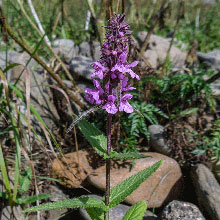
|
After
I’d found a safe observation
point by the cliffs I settled down on my trusty wee 3-legged stool and
almost immediately saw a pair of Puffins no more than about 30 mts
away. I could also see Razorbills, Fulmars and some Rock Doves.
Razorbill
|
Fulmar
|
Puffin
|
Rock Dove
|
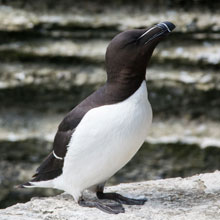
|
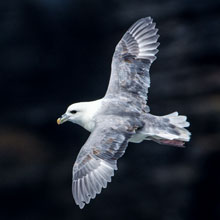
|
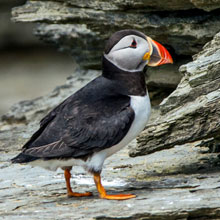
|
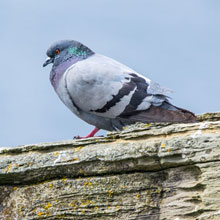
|
I climbed higher along the
cliff top
accompanied by a Great Black-backed
Gull sitting on the air current. On a fence post to my right a very
bold Rock
Pipit paid me little heed despite my close proximity and the fierceness
of the
wind. Just as I reached Kitchener’s
Monument
a bold Great Skua glided overhead. It was patrolling the cliffs seeking
out
tasty morsels, such as unattended chicks, but it passed without any
success,
much to the relief of the Guillemot colony clinging to the cliff walls.
Great
Black - backed
Gull
|
Rock Pipit
|
Great Skua
|
Black
Guillemots
|
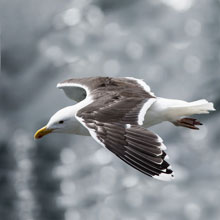
|
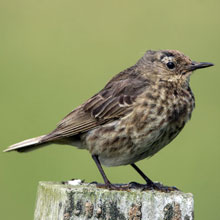
|
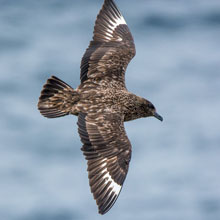
|
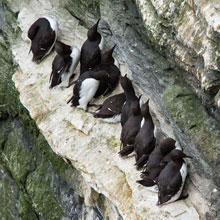
|
I spotted a
Fulmar chick sitting
on a rocky ledge. None of its parents were anywhere to be be seen, so
it had had a lucky escape. Its luck continued, as an Arctic Skua came
on the scene. The Skua was being mobbed by some Terns and Crows, so I
guess its attention was diverted from the cliff ledges to getting rid
of the nuisance birds. On my return journey along the rocky margins of
the shore I recorded images of Scots Lovage, a favourite of human
foragers as its foliage can be used in salads and pasta sauces. My
final picture was of a nervous Rabbit nibbling grass in the field
adjacent to the car park. I’d have liked a closer shot but it
darted
down its burrow before I could get any closer.
Fulmar Hatchling
|
Arctic Skua
|
Scot's Lovage
|
Rabbit
|
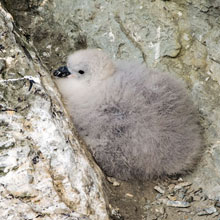
|
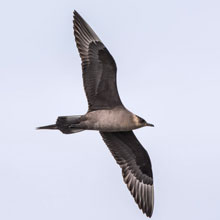
|
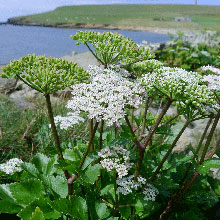
|
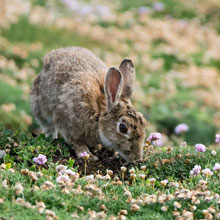
|
I hope you have
enjoyed these
ramblings. I’m pleased with the haul of sightings described
above from
the start of our holiday. I’ll cover the remainder of the
holiday in a
future blog.
Best of the
pictures:
Common Seal
|
Stonechat
|
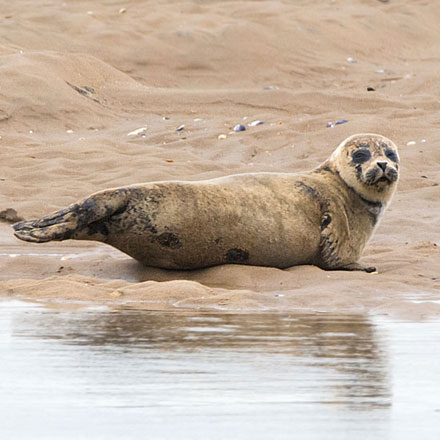
|
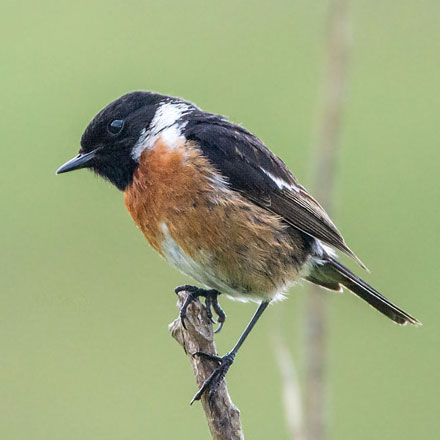
|
Razorbill
|
Great Skua
|
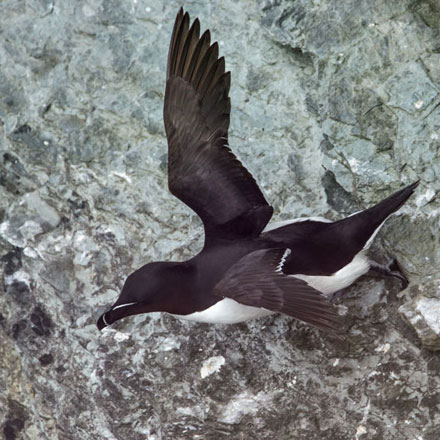
|
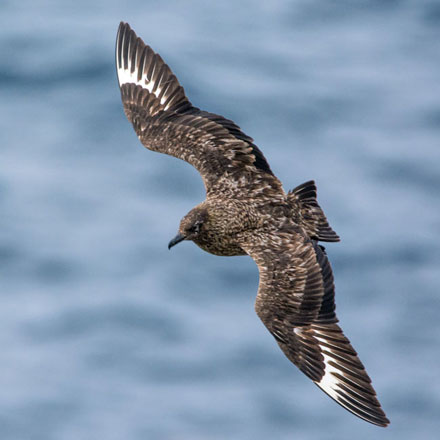
|
As the early
summer heatwave
extended into the second week of July, I must admit that part of my
reasoning in deciding to opt for Gullane Bents on Sunday was the
indication by the weatherman that it would be cooler in the east with
broken spells of sunshine. We had our Dalkeith Morrisons’
breakfasts
(disappointing 7.5/10) under grey skies but when we arrived at Gullane
the sky was azure blue. We were in for another scorcher. Gullane Bents
were already filling
with day trippers complete with chairs, canoes, surfboards and barbies.
All this cleared the area of wildlife, but we hoped that we’d
find
better nature watching conditions if we walked west over the rocky
shore
towards Aberlady LNR. And so it turned out. Soon an offshore Eider and
a wee scurrying male Pied Wagtail raised our spirits. The Wagtail was
catching flies as we could see by the contents of its beak. We were
cautiously watched by a Carrion Crow as we moved towards Bleaching
Rocks. I snapped a 6-spot Burnet Moth as it clung to a Goat’s Beard
bud, the first of many Burnets we would see.
Eider
|
Pied Wagtail
|
Carrion Crow
|
6 Spot Burnet Moth
|
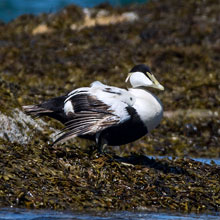
|
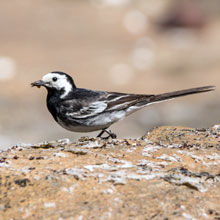
|
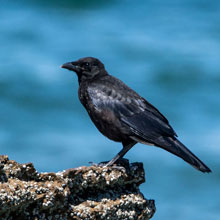
|
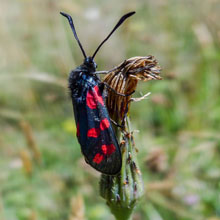
|
We were walking
beneath grassy
crags beyond which I could see banners set out on the Gullane golf
course in preparation for the Scottish Open championship. It is
interesting to note that Gullane is so named from the Gaelic for
“shoulder”. I noticed that the grassy banks at the
foot of the crags
were teeming with butterflies. I got some nice shots, first of a
Ringlet on Common Ragwort, then of a beautiful male Common Blue.
Females are not blue though, but, brown with orange spots at the edges
of their wings. We saw many orange and black-striped Cinnabar Moth
caterpillars, mainly on Ragwort. I got quite excited to come across a
Dark Green Fritillary Butterfly feeding on Knapweed. Although these
large, powerful butterflies are predominantly orange with brown /black
markings, there is a dark green tinge at the base of the underwing (see
“Pictures of the Week”, below) from which it gets
its name.
Ringlet Butterfly
|
Male Common Blue Butterfly
|
Cinnabar Moth Caterpillar
|
Dark Green Fritillary Butterfly
|
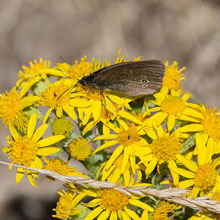
|
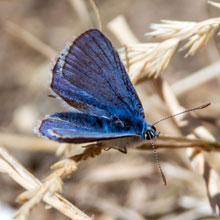
|
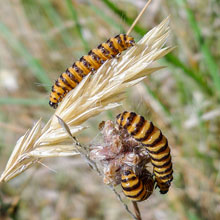
|
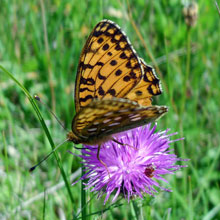
|
We descended
back onto the shore
as John had spotted a gathering of birds just off Gullane Point.
Prominent amongst these was a juvenile Cormorant standing over a large
group of eclipse Eiders. As we rounded the Hummell
Rocks I
noticed an
umbilifer with quite unusual leaves. It was Scot’s Lovage, an
edible
plant, with the flavour of celery. In the UK it is only found on
coasts, although, since it cannot tolerate grazing, it is seldom found
where sheep and birds are seen. I took a photo of a pretty little
Silverweed growing neatly on the pebbles of the foreshore. I also
recorded a large plant of Sea Plantain that had established itself on a
raised boulder.
Juvenile Cormorant
|
Scot's Lovage
|
Silverweed
|
Sea Plantain
|
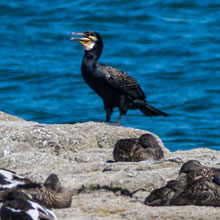
|
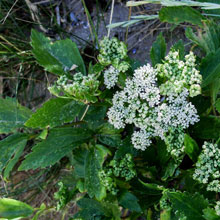
|
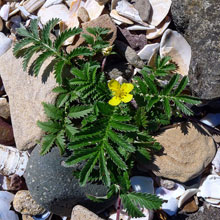
|
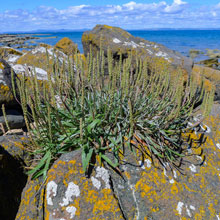
|
When
photographing plants, to ease
identification, I like to get shots from long and medium distances
followed by close-ups of flowers, leaves and stem. As I examined the
close-up of the Plantain I noticed one showed an infestation by tiny
red mites - plant-eating spiders, Tetranychus urticae. John drew my
attention to Gullane Bay where kite-boarders were having fun in the
sun. We rested
a bit on the grassy edges of the Point where I captured images of the
Small Heath butterfly and a Plume Moth that I think is the Yarrow Plume
Moth, Gillmeria pallidactyla.
| T.B.C. Red Mite |
View
|
Small Heath Butterfly
|
Yarrow Plume Moth
|
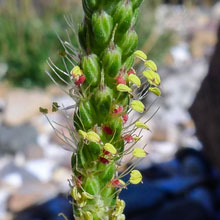
|
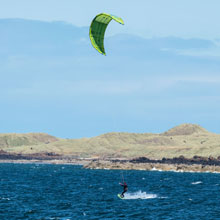
|
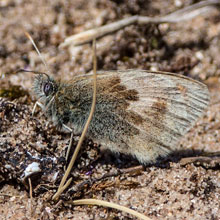
|
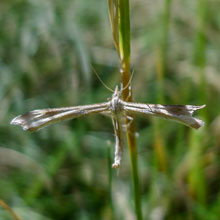
|
I also watched
an industrious
White-tailed Bumblebee pick its way through the small flowers of Wild
Thyme. A Small Skipper butterfly, aptly-named, as its
wingspan is
only
30mm, landed on Coltsfoot and hung around long
enough for me
to get
some great shots. The grass at the Point was not all that tall, so
there were other flowers growing there, such as the Wild Strawberry.
Once we had noticed them (they were about half the size of cultivated
strawberries) we realised that there were rather a lot of them hiding
beneath the grass. On our return journey we took a different route
after we passed the Hummell
Rocks. We found a footpath that ran the
length of the crags from the beach up to the car park. I found a trio
of insect species busy on a Creeping
Thistle. There was a Digger Wasp,
Ectemnius cephalotes and a 6-spot
Burnet Moth, each feeding, and a pair
of copulating Red
Soldier Beetles.
White - tailed Bumble Bee
|
Small Skipper Butterfly
|
Wild Strawberry
|
Digger
Wasp - Ectemnius cephalotes
|
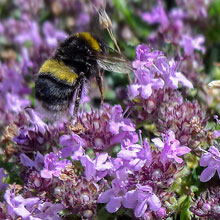
|
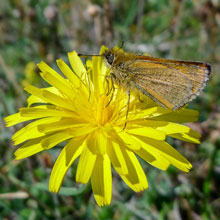
|
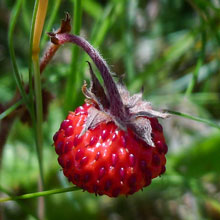
|
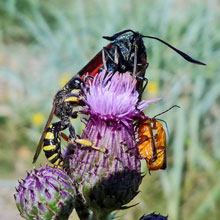
|
We passed a
couple of Lesser
Burdock plants that were just ready to flower. Folk medicines prepared
from the plant include treatments for snakebites, rabid dogs, burns,
sores ulcers, sciatica and many more. I was surprised to find an Apple
Tree perched precariously on the cliff side, although it would be a
brave person who would try to pick them. John pointed out a red-eyed,
grey-striped parisitoid fly called Nemorilla Floralis. (The final
adjective refers to its habit of it laying its eggs inside certain
butterflies and moths, where the fly larvae then develop).Our final
shot was of a Brown-lipped Snail in what could be a
“estivation” - when
the atmosphere is dry it retracts into its shell and becomes inactive
until the moisture in the atmosphere increases.
Lesser Burdock
|
Apple Tree
|
Fly - Nemorilla floralis |
Brown - lipped Snail
|
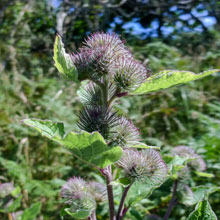
|
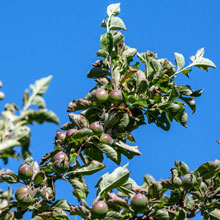
|
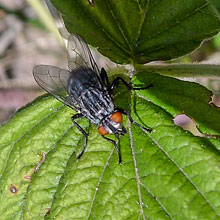
|
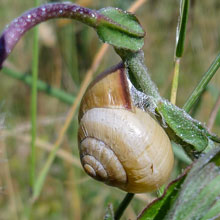
|
By
the time we reached the car we
were both fairly tired, ( I was completely and
utterly......tired. ED.) due to the rock scrambling required
throughout the trip and our final trek up the hill. Time then for
Almond and Custard Danish Pastries, washed down with cups of strong
tea - all in the shade of the hatchback door.
Pictures
of the Week:
Ringlet Butterfly
|
Common Blue Butterfly
|
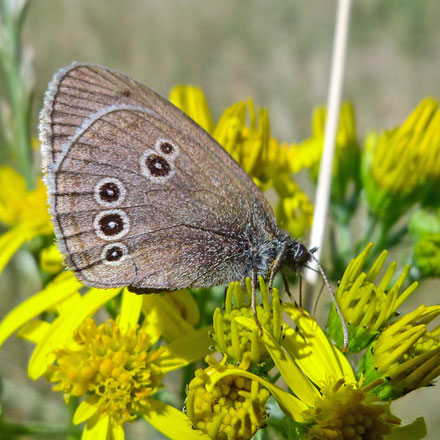
|
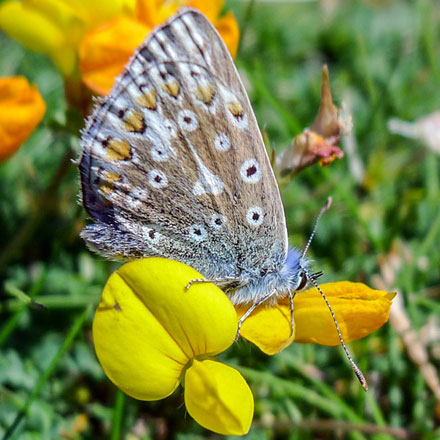
|
Small Skipper Butterfly
|
Dark Green Fritillary Butterfly
|
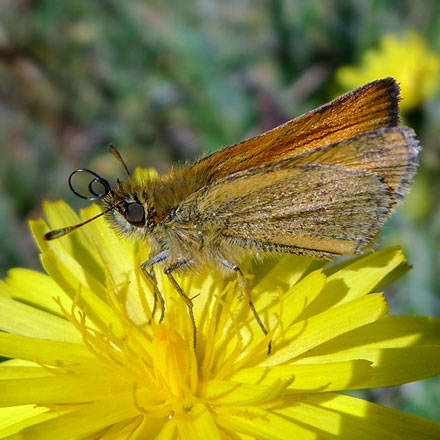
|
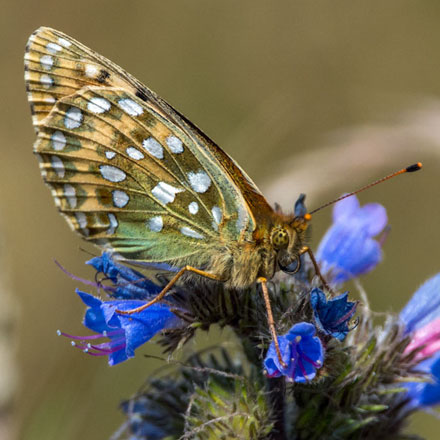
|
1st July 2018
Troon Harbour and Gailes
Marsh
For the second
week running we
found ourselves enjoying the fine breakfasts of the Kilmarnock Asda
Cafe (9.75/10 - 2 week average). Like the previous week, the weather
was warm and sunny. We were heading for SWT Gailes Marsh to check out
the flowers and insects. First though, while the tide was favourable,
we started at Troon Harbour. As we got out
the car, a juvenile
Pied Wagtail (although it may be a juvenile White Wagtail) was
foraging
around the car park. We decided to walk North along the shore towards
some Eider we spotted. A big clump of what looked like Cranesbill
decorated the approach to the shore. There was lots of Sea Mayweed and
Sandwort. The daisy-like Mayweed carries a slight scent similar to
Chamomile The only bird we could see on the rocks was a lone Herring
Gull, which disappointed us as we had expected a few waders.
Juvenile
Pied Wagtail
|
Cranesbill
|
Sea Mayweed
|
Herring Gull
|
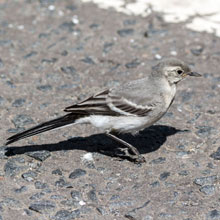
|

|
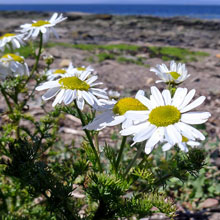
|
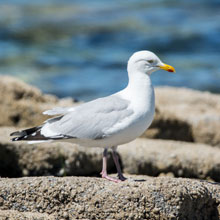
|
Then as I took
in the beautiful
vista before us, of yachts sailing on azure sea with the Isle of Arran
in the distance, some movement on the rocky shore in front of me caught
my eye. It was a pair of Ringed Plovers scurrying across the shore
seeking out flies, spiders, marine worms, small crustaceans and
molluscs. Then, as as couple of vessels entered the Harbour, I spotted
a Black Guillemot skimming the water before coming to rest on a ledge
of the Harbour wall. These birds are in the Auk family (which includes
the Puffin). Those in the UK are Cepphus
grylle arcticus, one of 5 subspecies found world-wide.
After a
time it flew off into the harbour.
After that we
had a fairly close
fly-past of a Gannet, probably it was on a day trip from Ailsa Craig.
John pointed out a pair of Shags sitting at the end of the same ledge
of the wall that the Black Guillemot was on. A lonely Oystercatcher
landed by some seaweed before I managed to spook it in my clumsy
attempts to get a closer picture. As we returned to the car park I
snapped a shot of Sea Rocket. This plant is a member of the Mustard
family.
Gannet
|
Shag
|
Oystercatcher
|
Sea Rocket
|
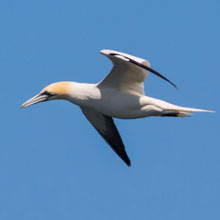
|
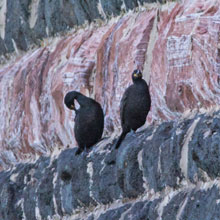
|
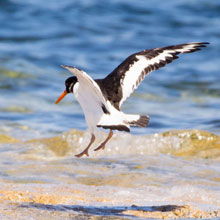
|
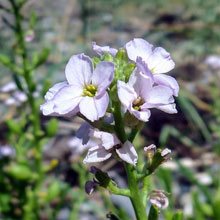
|
We next
explored the south side of
the shore. My eye followed an adult Starling picking its way across the
rocky shore. Its plumage was very iridescent, in the strong sunlight.
We startled a small group of Linnets we hadn’t noticed as
they fed amid
patches of long grass on the rocks. John drew my attention to a dead
Jellyfish that had probably been stranded in a temporary rock pool. On
our way back to the car I photographed a Small White butterfly as it
rested on grass by the path. It is also called the Small Cabbage White,
distinguishable from the Large
White
by its small spots and black tips
to its forewings.
Starling
|
Linnet
|
Jellyfish
|
Small White Butterfly
|
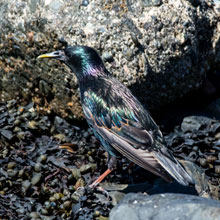
|
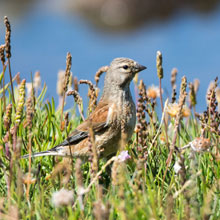
|
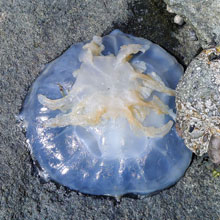
|
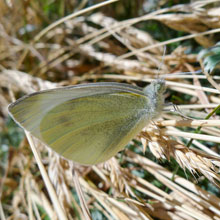 |
It was a short
drive North up the
coast to Gailes Marsh, a Scottish Wildlife Trust Reserve south of
Irvine. At the very start of the walk we found the first of many Common
Ragwort plants that were festooned with orange and black banded
Cinnabar Moth caterpillars. I liked the look of a Wild Rose further
along the path and, as I photographed it, a 6-Spot Burnet moth whizzed
past my head and descended onto a Meadow Vetchling flower. So I
photographed it too. We were watching out for dragonflies so we sat
close to the Marsh and waited for them. I soon came across a few plants
of Lesser Spearwort, a member of the family of Buttercups.
Cinnabar Moth Caterpillar
|
Wild Rose
|
6 Spot Burnet Moth
|
Lesser Spearwort
|
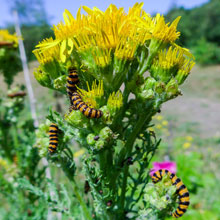
|
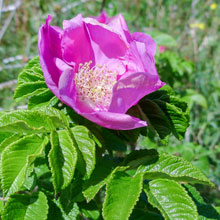
|
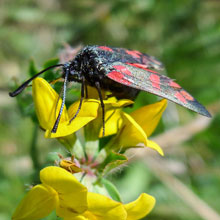
|
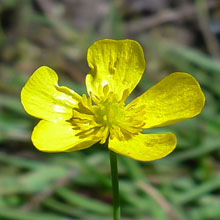
|
On our walk to
the marsh we had
noticed the many Common Blue butterflies darting about. They
didn’t
land too often, and when they did they didn’t stop long
enough for me
to snap them. At the marsh we decided to wait for them coming to us -
well, to the Birdsfoot Trefoil we had sat beside.
It paid off as before too long I got a passable shot. A wee Goldfinch
juvenile sat nervously in a nearby bush before its nerves got the
better of at and it flew off. We came upon a sand bank where we watched
the comings and goings of Sand Martins feeding their nestlings.
As time was
getting on, and
although we had seen no dragonflies, we pressed on around the path that
would lead us back to the car. John pointed out a Small Heath butterfly
on some Gorse (see
“Pictures of the
Week”, below). Immediately after this I
located a male Emerald Damselfly (also below) clinging to a reed. The
final leg of our route took us past a open area of tall grasses
bordered by elegant Common Valerian plants and lower, but lovely
patches of Tormentil with their tiny yellow flowers. Thirty metres from
the car I found two members of the same species, Common and Greater
Bird’s-foot Trefoil. They differ as you might expect - the
Greater is
taller and has bigger leaves.
Common
Valerian
|
Tormentil
|
Common
Bird's - foot
Trefoil
|
Greater Bird's - foot Trefoil
|
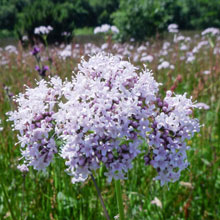
|
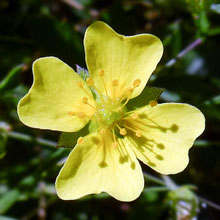
|
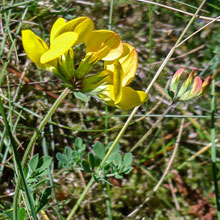
|
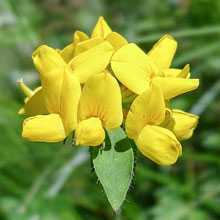
|
Yet another
very enjoyable outing
to two very different locations, each of them yielding some interesting
sightings. The accompaniment to our tea this week were jam and
cream-filled muffins, a very satisfactory end to the day.
Pictures of the
Week:
Linnet
|
6 Spot Burnet Moth
|
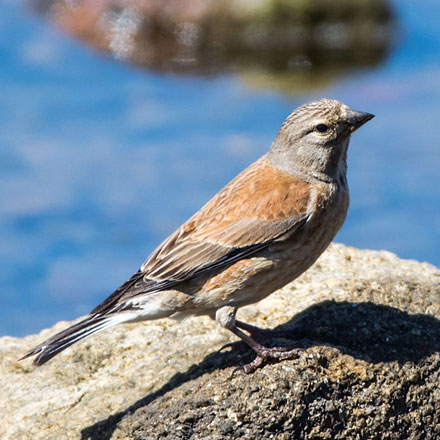
|
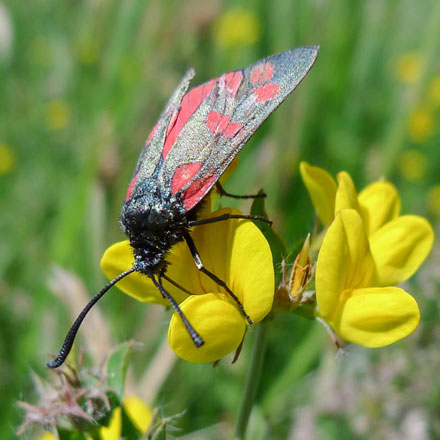
|
Small Heath Butterfly
|
Emerald Damselfly
|
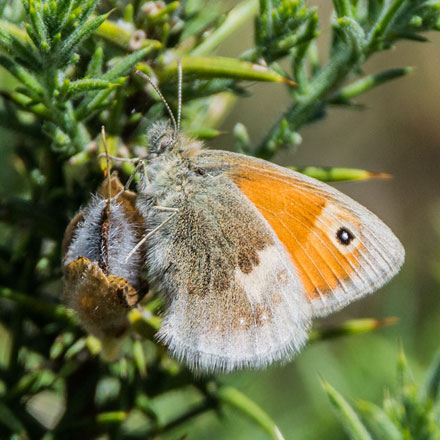
|
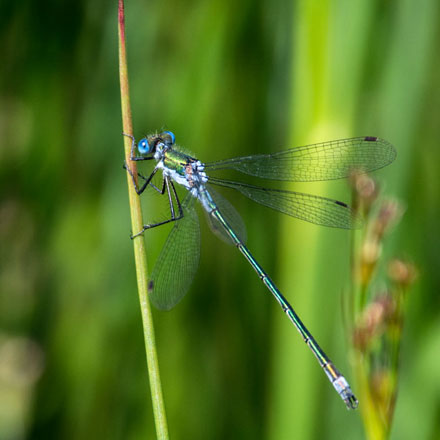
|
Back To Top
|

